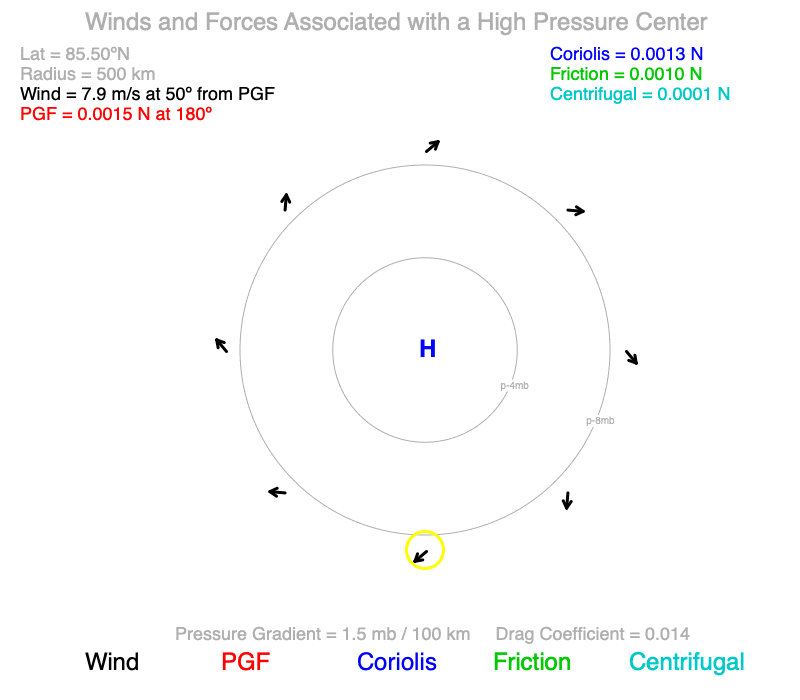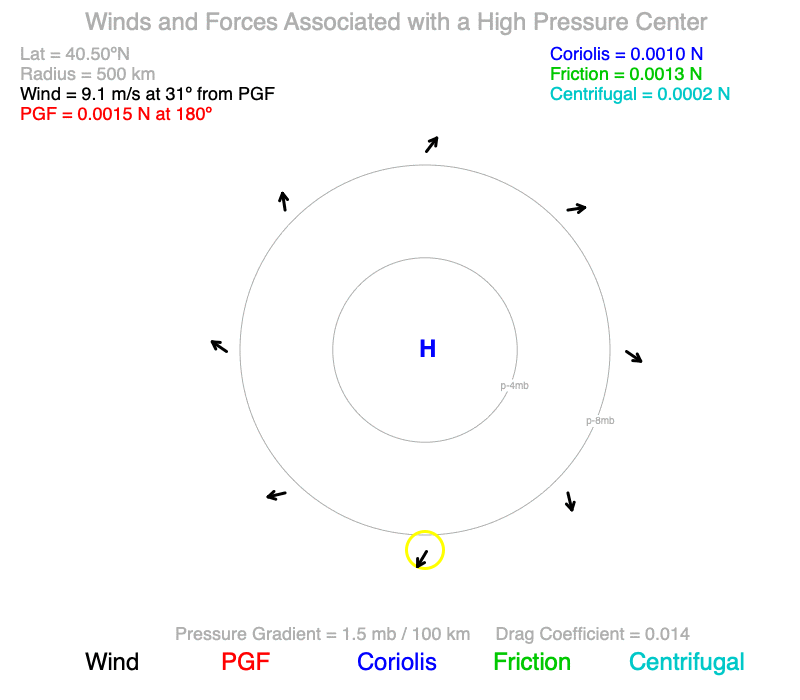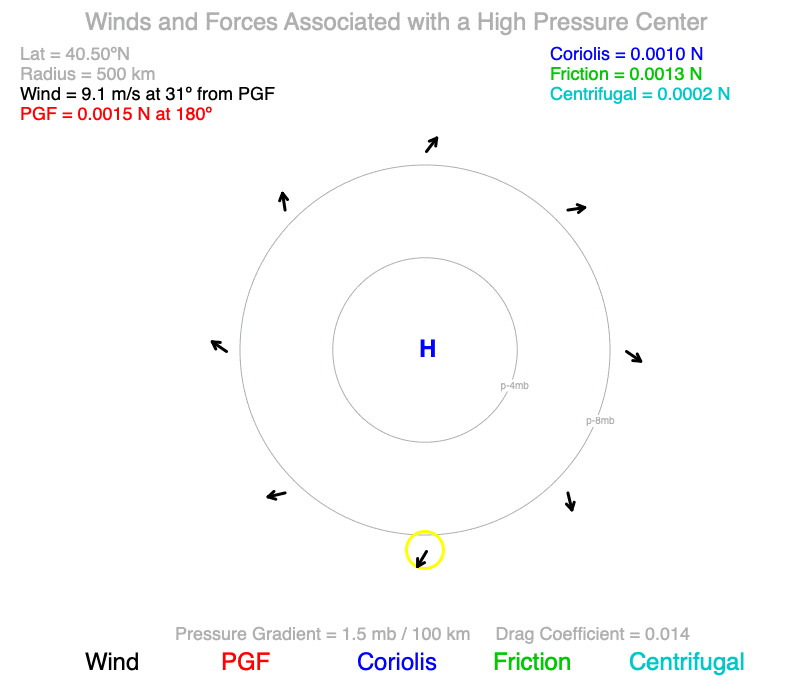Winds Around a High-Pressure Center
There are many similar traits between winds around a high-pressure center and those around a low.
1) Both have a physical size to them, so latitude changes with location. In the examples below, the outer winds are 500 km from the center. One degree latitude equals 111 km, so the distance between the northernmost wind and the southernmost is 9º latitude. The magnitude and direction of the Coriolis force depend on the latitude, so Coriolis force is not uniform across these pressure systems.
2) Winds curve as they travel around the center of the pressure system, so they experience centrifugal force. We are dealing with four forces acting on the moving air: pressure gradient force, friction, Coriolis force, and centrifugal force.
The significant differences between high and low-pressure systems are the magnitude of the pressure gradient, and the pressure-gradient is not linear across the region near the center. High-pressure systems are limited to relatively weak pressure gradients, whereas lows may have extreme pressure gradients (hurricanes and tornadoes!). The shape of the pressure gradient is more like a rounded bowl. The winds near the center are very light and have been omitted from the animations below.
Effect of Coriolis Force (Latitude)
The pressure center’s latitude starts at 90ºN in changes in 10º increments to the south. The pressure gradient is 1.5 mb / 100 km toward the center, and the drag coefficient is representative of a forest creating friction with the moving air.
The reasons for the observed patterns are nearly identical to those for the low-pressure centers.

What patterns do you observe as latitude changes?
The angle the winds cross the isobars is called the cross-isobar angle.
1) The cross-isobar angle increases as the latitudes approach the Equator (0º), so the winds flow more directly toward the center.
2) Winds spiral clockwise toward the high-pressure center in the Northern Hemisphere and counterclockwise in the Southern Hemisphere.
3) Something odd is happening when the latitude of the pressure center is at the Equator (0º). Winds at 0º could not be calculated mathematically. Notice that the winds in the Northern Hemisphere (the upper half of the image) are turning clockwise, and the winds in the Southern Hemisphere (bottom half) are turning counterclockwise.
Effect of Pressure Gradient
The pressure gradient begins at 1.5 mb / 100 km and decreases in 0.1 mb / 100 km increments. The pressure center’s latitude is 45ºN, and the drag coefficient is representative of a forest creating friction with the moving air.
The reasons for the observed patterns are nearly identical to those for the low-pressure centers.

What patterns do you observe as pressure gradient decreases?
The angle the winds cross the isobars is called the cross-isobar angle.
1) The cross-isobar angle decreases as the pressure gradient weakens.
2) Wind speed decreases at the pressure gradient decreases.
Effect of Friction (Drag Coefficient)
In these animations, the drag coefficient, which characterizes the roughness of the surface interacting with the wind) decreases from 0.014 (a forest) to 0.012 (sparse forest). The calculations could not converge to values outside this limited range of drag coefficients. The pressure gradient across the area is 1.5 mb / 100 km, and the pressure center’s latitude is 45ºN.
The reasons for the observed patterns are nearly identical to those for the low-pressure centers.

What patterns do you observe as friction decreases?
The angle the winds cross the isobars is called the cross-isobar angle.
1) The cross-isobar angle decreases as the drag coefficient decreases (friction decreases). When frictionless, the winds are parallel to the isobars, so they are not diverging from the high-pressure center.
2) Wind speed increases as friction decreases.
Role of Centrifugal Force
Centrifugal force points radially away from the center of curvature. In both the generalized high- and low-pressure scenarios presented, the center of curvature is also the center of the circular isobars. In low-pressure systems, centrifugal force opposed the pressure gradient force, so wind speed decreased toward the center. In high-pressure systems, centrifugal force and the pressure gradient force are in the same direction, so wind speed is enhanced. For a given pressure gradient, latitude, and drag coefficient (friction), wind speed will be higher in a high-pressure situation than a low-pressure one.
Continue to Explore Winds
Use the desktop app, Earth, Wind, and Forces, to explore winds flowing from high-pressure centers on Earth. Go to the Software page to download a version for Macs or PCs.

0 Comments